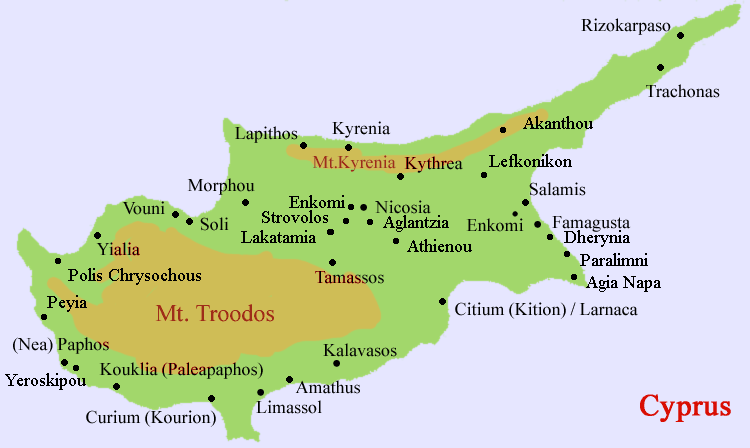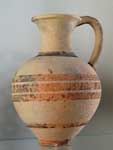|
|

Enkomi/Tuzla (35°9′30″N, 33°53′28″E, in north-western Cyprus), a village near Famagusta, is the cite of an important Bronze Age city, possibly the capital of Alasiya.
From ca. the 16th century BC, it was an important trading center for copper. From the 13th century, there are competing towns along the south coast. From ca. 1200 BC, Enkomi was fortified. After an earthquake ca. 1050 BC, the site was abandoned, resulting in the rise of Salamis.
The site was excavated by A. S. Murray for the British Museum from 1896. From the 1930s, excavations were continued by Claude F. A. Schaeffer.
Notable finds from Enkomi include Linear C inscriptions and the so-called "horned god", a bronze statue dated to the early 12th century BC, depicting a deity wearing a horned helmet. Another well known statue is the "ingot god", a statue wearing a horned conical hat and greaves, is armed with shield and spear, and standing on a miniature hide-shaped ingot.
Literature
- A. S. Murray, 'Excavations at Enkomi', in A. S. Murray/A. H. Smith/H. B. Walters (eds.), Excavations in Cyprus (London, British Museum, 1900).
- E. J. Peltenburg, 'From isolation to state formation in Cyprus: ca. 3500-1500 BC', in Vassos Karageorghis/D. Michalides (eds.), The development of the Cypriot economy from the prehistoric period to the present day (Nikosia 1999) 17-43.
- Claude F. A. Schaeffer, Nouvelles découvertes à Enkomi (Chypre). Comptes rendus, Académie des Inscriptions et Belles Lettres Paris, 1949.
- Claude F. A. Schaeffer, Enkomi-Alasia I (Paris 1952).
Archaeological sites , ancient cities in Cyprus
|
Retrieved from "http://en.wikipedia.org"
All text is available under the terms of the GNU Free Documentation License
|
Ancient Greece
|
Medieval Greece / Byzantine Empire
|
Modern Greece
|
|
Science, Technology , Medicine , Warfare
, Biographies , Life , Cities/Places/Maps , Arts , Literature , Philosophy ,Olympics, Mythology , History , Images
|
Science, Technology, Arts
, Warfare , Literature, Biographies
Icons, History
|
Cities, Islands, Regions, Fauna/Flora ,
Biographies , History , Warfare
Science/Technology, Literature, Music , Arts , Film/Actors , Sport , Fashion
|

|
|




